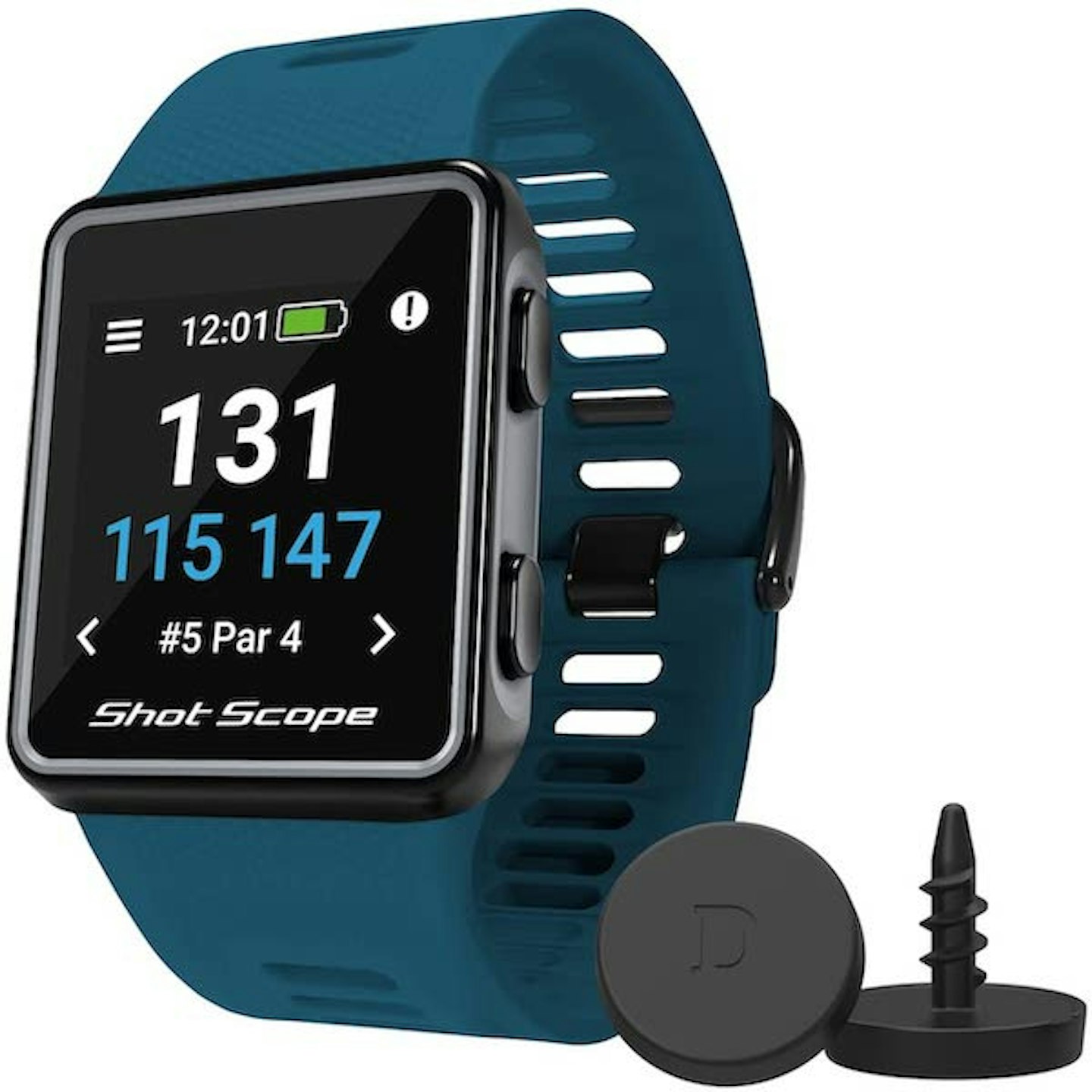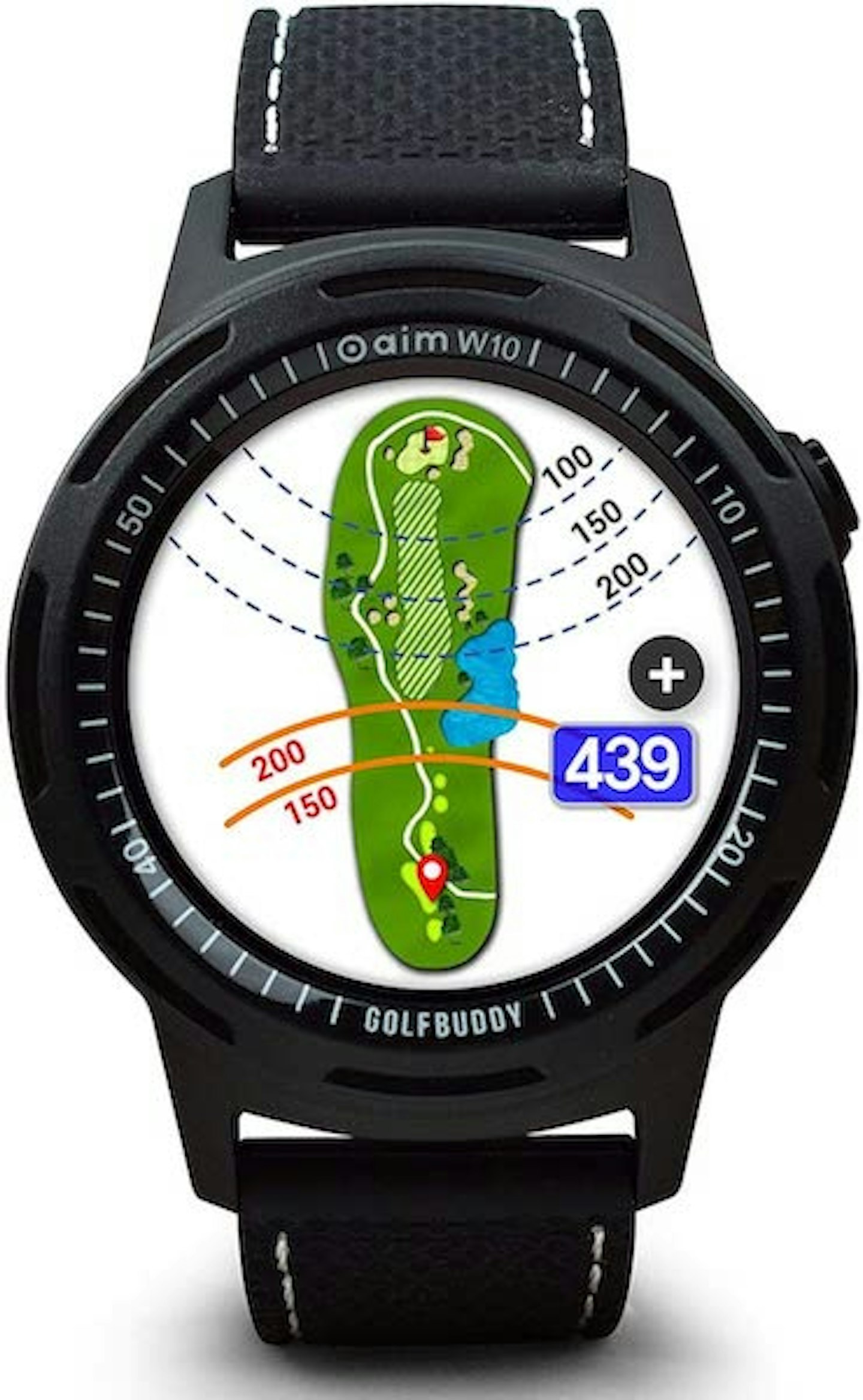In 2024, the best golf watches carry a wide range of useful features for new and seasoned golfers alike. In addition to using GPS to provide information on yardage and green location, they can replace your scorecard, provide tips and feedback, and generally make your life a tonne easier. To help you find the right GPS-powered golf watch, What's The Best has rounded up the very best below.
What is a golf watch?
If you’re new to golf or looking to buy a gift for a keen golfer, you may be wondering what a golf watch is and what it can offer. Well, the short answer is lots, but here’s a little more information for you:
Green and hole distance: By using GPS tracking and map data, a golf watch can show the distance of the next hole. The best golf watches carry pre-loaded data from thousands of golf courses, giving accurate information that will have you playing like a local. Some watches even offer a top-down view of the green. More courses and information can be added to the golf watch via apps and updates.
Keep score: Some golf watches keep a track of your swings, meaning you and your fellow competitors don’t need to keep count. This is pretty useful, allowing you to focus on your swing.
Personal caddie: Over time, some golf watches learn your average yardage for you every club in your bag. You can use this information to inform your next swing (or certain models will even recommend the next club for you).
Fitness tracking: Some golf watches bundle golf-specific features with general fitness tracking. These devices will not only follow your game, but track steps, calories and distance walked.
If you’d like to know more about the best golf watches, head to our buyer’s guide at the end of this page. Here we discuss GPS accuracy, using an Apple Watch for golf, and how golf watches fare against laser rangefinders and handheld GPS devices.
The best golf watches in 2024:
Best entry-level golf watch
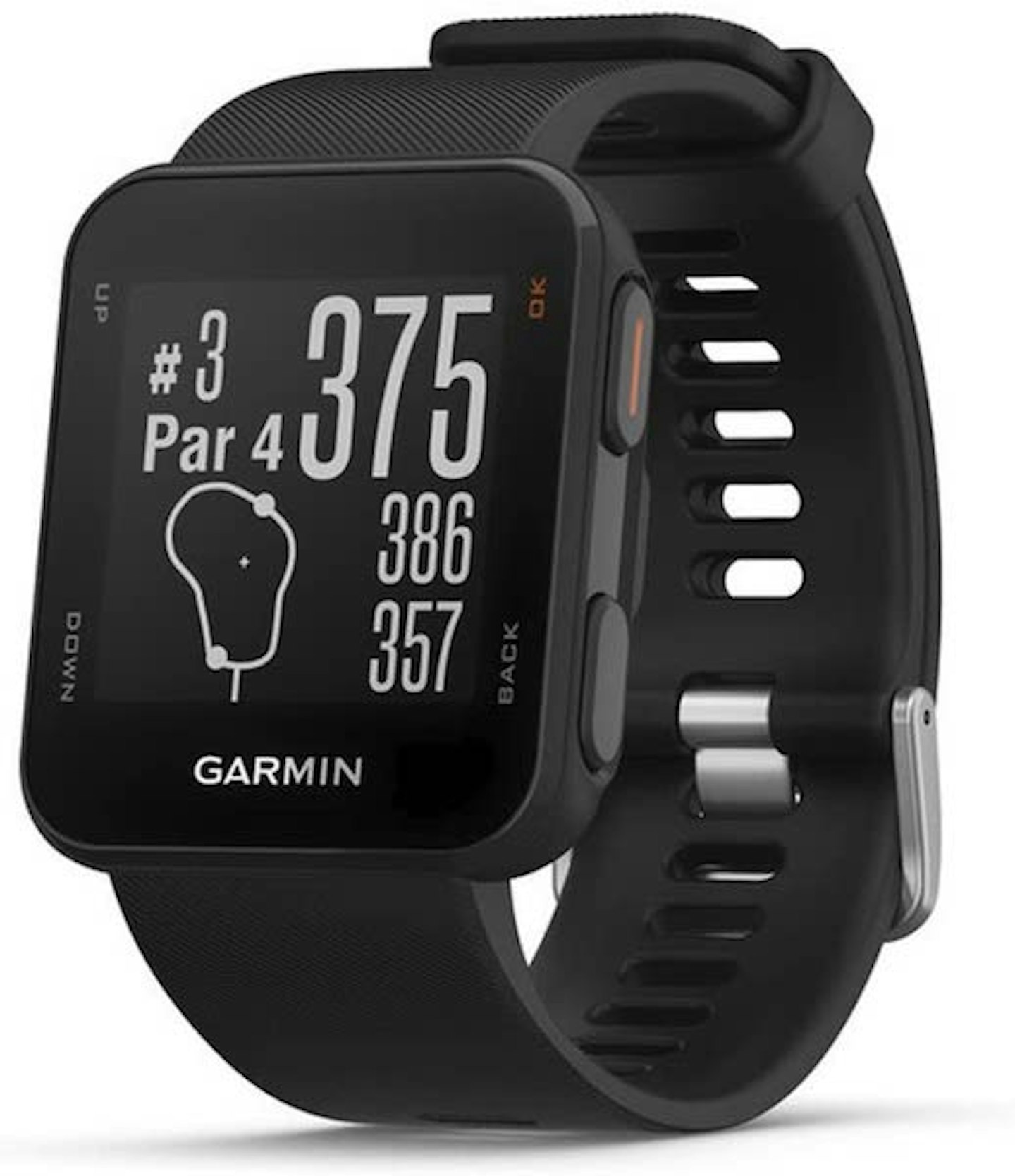
Garmin has led the golf watch market for many years and its entry model, the Garmin Approach S10, will really help your golf game. While the Approach S10 may not offer as many features as some of the more expensive golf watches, its price and simplicity are appealing.
The Approach S10 is sleek and lightweight, with a high-resolution display that is easy to read in all conditions. It can keep score, and it automatically adds up the total distance you’ve covered and the time you’ve spent playing. It doesn’t track your game the way some of the pricier golf watches do, but you can use it to keep score during your round and then upload each round you play to Garmin Express to keep track of your scores throughout the season. There’s no extra cost for doing that.
The Garmin Approach S10 comes preloaded with 41,000 worldwide golf courses and the watch will automatically identify the course you’re playing using your GPS location. The Approach S10 provides accurate yardages to the front, middle and back of the green, and alerts you to hazards and doglegs. For a fuss-free life, the Approach S10 can also tell when you’ve finished a hole and automatically display information for the next.
With a battery life of up to 12 hours, it’s good enough for two rounds of golf between charges.
Pros
- Trustworthy name
- Nice battery life
- Lightweight and stylish
- Easy to use
- Plenty of features
Cons
- No comprehensive stat-tracking
| Battery life using GPS: | 12 hours |
| Number of courses: | 41,000 |
Best stat-tracking
The ShotScope V3 comes with 35,000 courses pre-loaded and shows yardages to the front, middle and back of the green. Pretty standard stuff, but have no fear, it can do much more than that. ShotScope claims that by using dual satellite technology, the V3 carries the most accurate golf GPS available, cutting the competition's standard accuracy from between three and five metres to just 30cm.
The ShotScope V3 golf watch comes with 16 sensors - one to screw into each end of your clubs, with two spares. (Don’t worry, they are so small and light you won’t notice them). These sensors let the watch automatically detect every shot you hit and map your entire round, shot-by-shot.
The amount of analytics the ShotScope V3 offers is fantastic and very detailed. It gives you over 100 statistics, covering the kind of things you normally see on tour. These statistics can provide you insights into your game by helping you to determine the areas needing work.
Here are a few examples of what the ShotScope V3 can show you, but there are loads more:
• Approach shot proximity to the hole
• Greens in regulation
• Up and down percentage
• Driving distance
• Fairways hit or missed (left and right indication)
• Average yardage with each club, plus your longest shot with each club
• Putts per round
• Putts holed percentage from different distances
• Average holes per three-putt
The V3 is also ShotScope's most compact and stylish watch to date, with the previous V2 being pretty bulky on the wrist. The battery life is just about right for two rounds, too.
Pros
- Tracks a huge number of different statistics
- Competitively priced
- Stylish watch with interchangeable straps
Cons
- You may miss important events as you get absorbed in looking over your vast amount of statistics
| Battery life using GPS: | 10+ hours |
| Number of courses: | 35,000 |
Best GPS
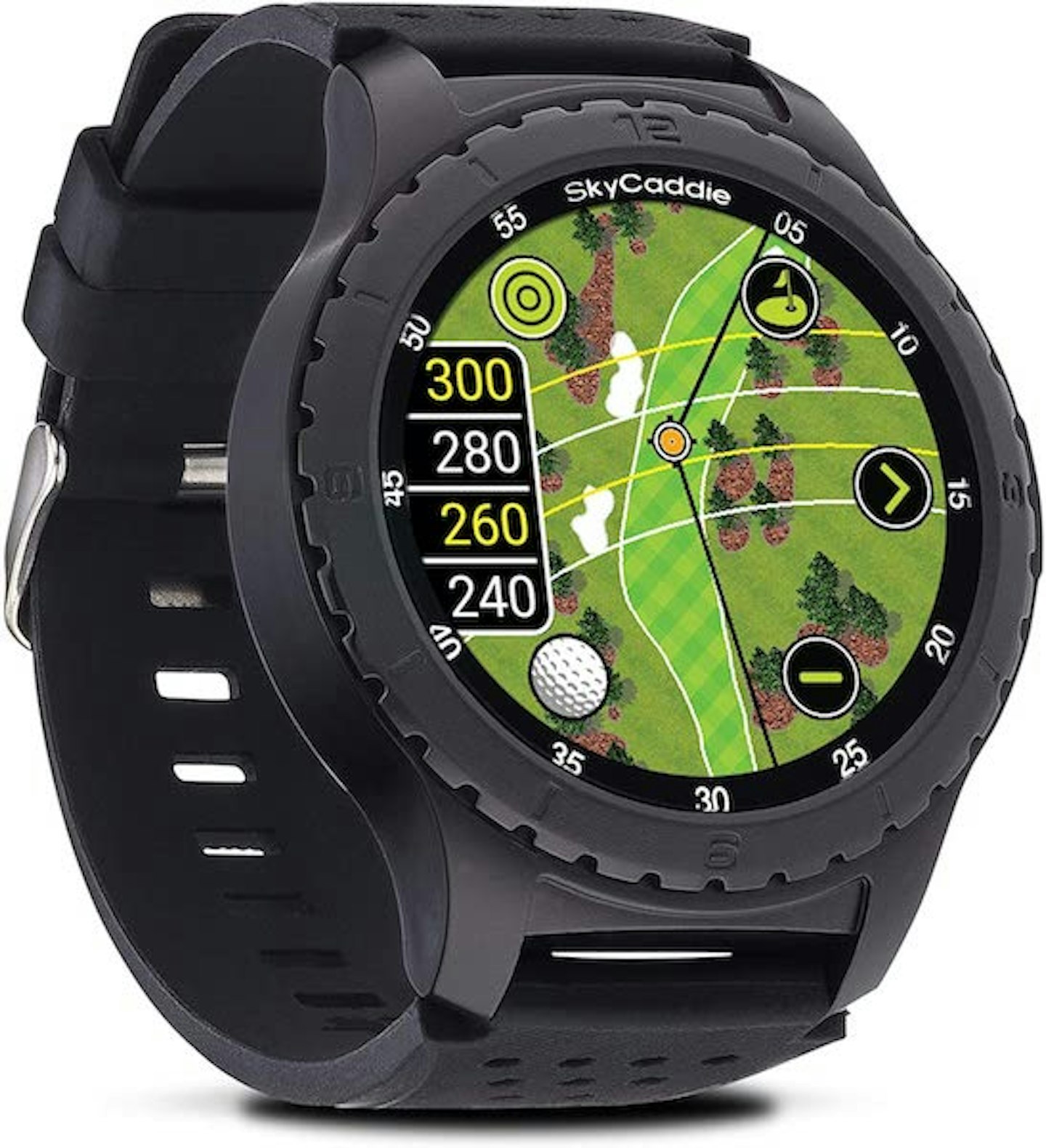
Fanatical about accurate GPS readings? The SkyCaddie LX5 is for you. Rather than relying on satellite and remote measurements, SkyCaddie regularly goes out and measure courses on foot.
It’s time for a quick story: Two years ago SkyCaddie introduced a new level of detail with the SX500 handheld GPS. Similar in dimensions to a plus-size mobile phone, the touchscreen device happily calculated yardages to any point on the course. But the feature that really sold it was how it showed how far was left behind a flag, and how much green there was to play with either side of the flag – features a laser could never compete with.
So in depth was the yardage information the system produced that, for the first time, several high profile tour players adopted the system and ditched their yardage books forever. When you’re playing for your livelihood and a wedge of cash every season, that’s a really big deal.
Wind the clock forward a few years and SkyCaddie has rolled out the same kind of functionality into a watch - the LX5 GPS.
Pros
- Zoom and panning functions give yardages to any point on the golf course
- Shows how much space there is in front, behind and to either side of the flag
- Supreme accuracy
Cons
- Subscription required after initial 3-year membership
| Battery life using GPS: | Up to two rounds |
| Number of courses: | 35,000 |
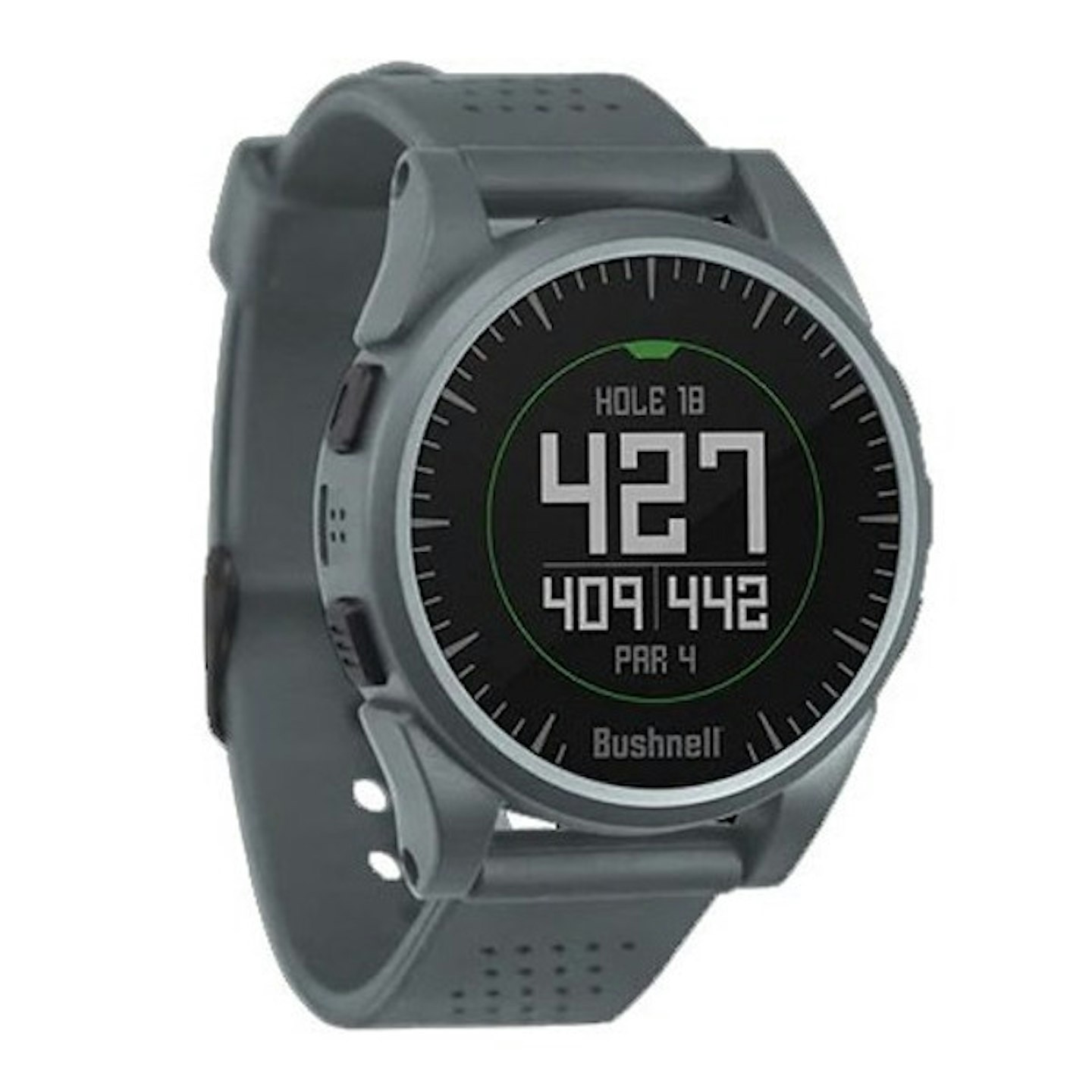
golfbase.co.uk
The Bushnell Excel GPS watch is a smart golf watch, offering all the yardages to the front, middle and back of the green, as you would expect. It’ll also display the distances of up to four hazards and lets you easily record shot distances and round time. Plus, the Bushnell Excel is also one of, if not the best-looking golf watches available.
Pairing the Excel with a smartphone and the free Bushnell Golf App unlocks a few more exciting features. Paired with your phone, you'll get full-colour aerial hole layouts, 3D flyovers, swing analysis and you can even book tee times. It's a seriously clever piece of kit, especially given the competitive price.
Pros
- Very stylish watch
- Great features when paired with the app
- Good battery life and very quick to charge
Cons
- Visible screen size is small, making up less than half of the watch face
| Battery life using GPS: | 14 hours |
| Number of courses: | 35,000+ |
Best premium
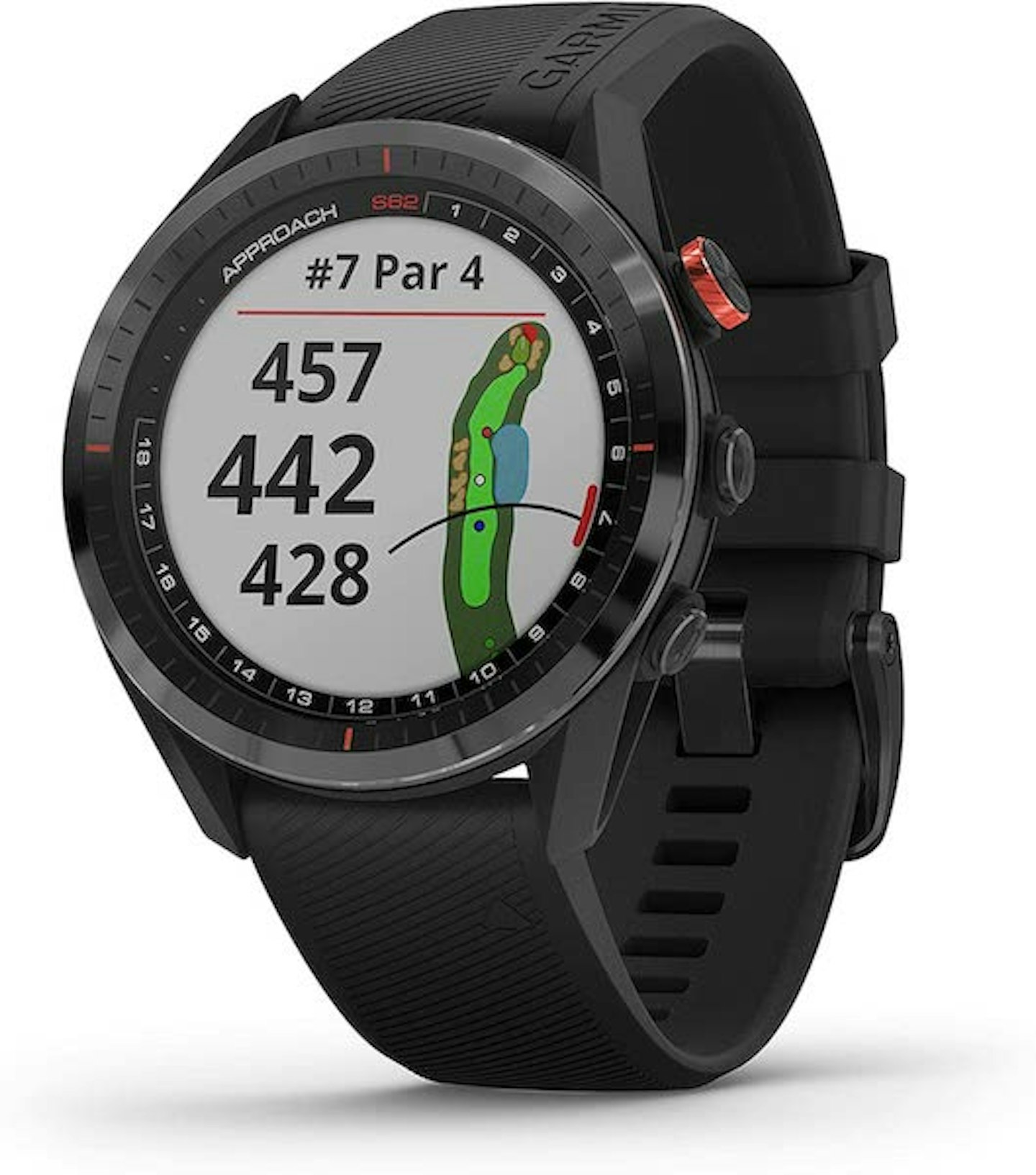
Based on price alone, the Garmin Approach S62 won't be the golf watch for everyone. However, if you can afford it, it’s simply the best golf watch money can buy.
The Approach S62 is stylish enough for the golf course and daily life. And you can do that too, as the battery life will last up to a fortnight when you're just using it as a normal watch. In golf mode, the battery life is up to 20 hours, which is a lot longer than most golf GPS watches.
The Garmin Approach S62 has a nicely sized full-colour 1.3" display, which is readable even in bright sunlight. The display comes in particularly handy when using the 'Green View' feature, which shows the true shape of the green and lets you zoom in and drag-and-drop the pin for improved accuracy. The 'Hazard View' lets you quickly scroll through each hazard and get a yardage to the front and back, helping you decide whether to lay up or take on the carry distance. If you've carved a shot into the woods and lost the green, or if you're just playing a blind approach shot, the Garmin Approach S62's 'PinPointer' will act as a compass and point you in the right direction.
To help improve your game and keep track of progress, the Garmin Approach S62 also collects stats. Pair it with the Garmin Golf app to get a good look at the information. The watch itself can use the information to act as a caddie on your wrist - it will consider wind speed and direction to suggest a club based on the distance you typically hit with each of the clubs in your bag.
Prefer to pick the club yourself? Not a problem, the Approach S62 makes that easier, offering adjusted distances to allow for uphill and downhill shots, and wind speed and direction. It’s so helpful, it can feel like cheating. In fact, in some situations, it is. Some of its features aren’t allowed in most golf competitions. Luckily you can turn them off and use the Garmin Approach S62 as a standard golf watch.
The Garmin Approach S62 is a lot more than just a fantastic golf watch. It monitors your heart rate and can even estimate blood oxygen levels. It can receive emails and texts. And it can also be used for running, cycling and swimming, as well as golf. You can even use it to make contactless payments via Garmin Pay.
Pros
- Has everything you could want from a golf watch
- Lots of features that will genuinely help you save shots on the course
- Excellent battery life
- Stylish package
Cons
- The volume of features will be needlessly complicated for some
| Battery life using GPS: | 20 hours |
| Number of courses: | 41,000 |
Best touchscreen
Though a lesser-known name than Garmin or SkyCaddie, the GolfBuddy Aim W10 is a great mid-range golf watch. Its most impressive feature is its full-colour touchscreen display. This screen can zoom in and out around the green, accurately place the pin in the right spot, and even see green undulations.
The GolfBuddy Aim W10 also offers slope-adjusted distances and can sync with your smartphone via the GolfBuddy app. The GolfBuddy W10 comes loaded with an impressive 40,000 courses, and you get free updates.
The 11-hour battery life means the GolfBuddy Aim W10 golf watch will easily get you through two rounds between charges, or possibly three if you get a move on.
Pros
- Touch screen is impressive and useful
- Zoom in/out function is excellent
Cons
- Some will prefer a more well-known brand
| Battery life using GPS: | 11 hours |
| Number of courses: | 40,000 |
Golf watches: A buyer’s guide
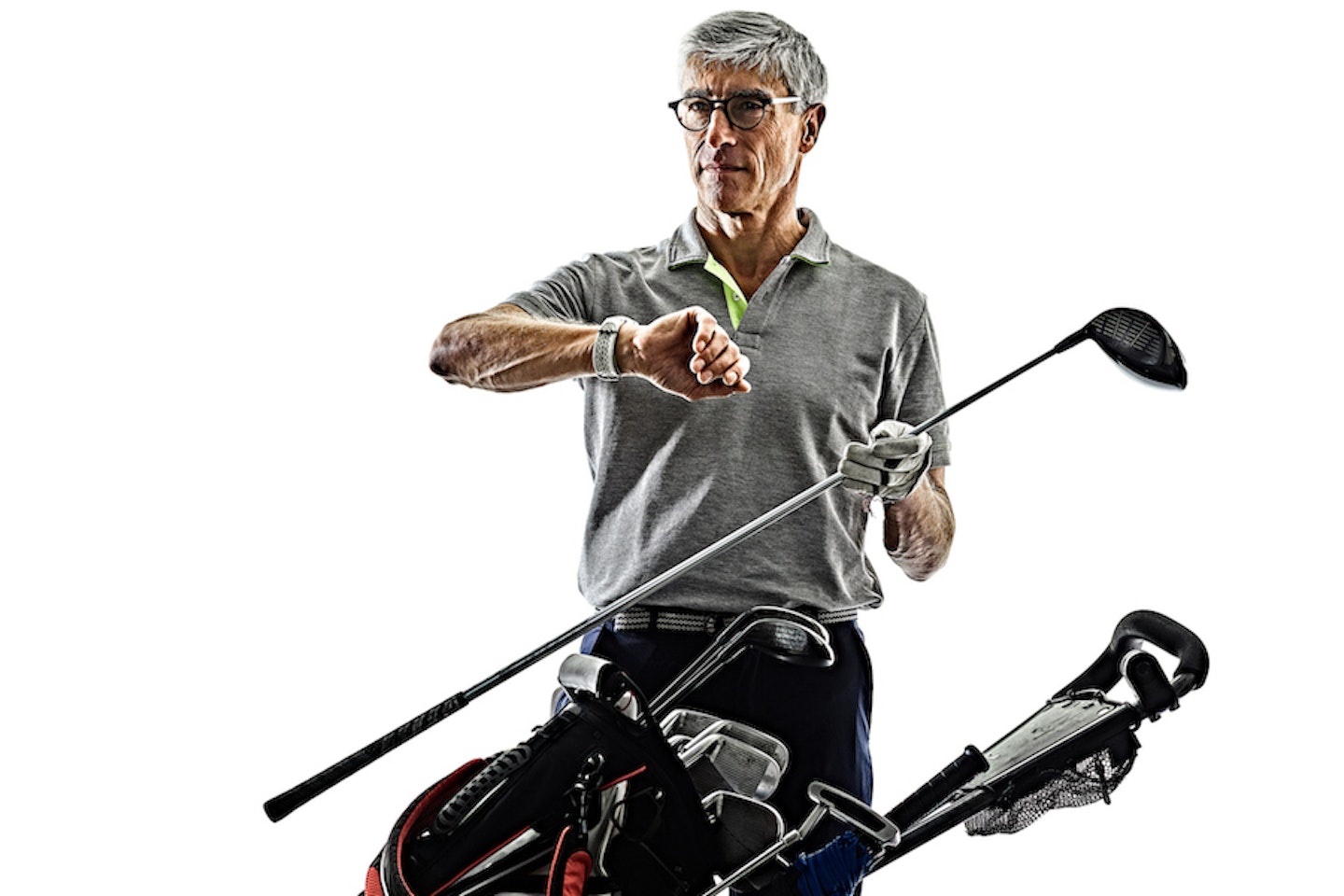
How accurate are golf GPS watches?
Golf watches are very accurate, getting the measurements to the green to within a yard or two. The new ShotScope V3 claims an accuracy of 30cm, which will be close enough for even the most accurate golfers.
Can I use an Apple Watch for golf?
Technically, yes. However, the Apple Watch isn’t a specialised device for golfing, and it shows. Besides text, calendar and email notifications disrupting your game, the whole thing is a bit of a faff.
To use an Apple Watch for golf, you will need a third-party app like Golfshot or 18Birdies. Apps like these are paid-for or involve some kind of subscription to get the full service. You'll also need your phone to be involved in the process of playing golf, usually at the start and end of the round.
Many of the apps will be taking measurements from your phone and displaying them on your watch. This isn't helpful at all unless your bag is right next to you.
If you have an Apple Watch and don't want to buy a second watch purely for golf, then it can and will do a job for you. But if you're choosing the best golf watch from everything available, the Apple Watch would be some way down the list.
Golf watch vs laser rangefinder vs handheld GPS
Golf watch
Pros:
Quick - Golf watches are the quickest to use of the three options. All you need to do is glance down at your wrist and you have all the information you need.
Stat-tracking – Most golf watches now offer some form of stat-tracking. This is priceless information when you are working out the strengths and weaknesses in your game.
Overhead views – Some of the more advanced golf GPS watches can give you a bird's-eye view of the hole, which helps you plot your shots and play smart shots to avoid hazards.
Neutral:
Battery – Most of the best golf watches will last you two 18-hole rounds of golf on one charge, but if you're on a golf holiday and forget your charger, there's nothing you can do. The majority of golf lasers use replaceable batteries and will last for months, if not years, without needing to be replaced.
Cons:
Feeling on the wrist – Most modern golf watches aren't overly bulky, but some golfers don't like the feeling of a golf watch on their wrist when they play.
Not as accurate as lasers – Golf GPS watches are accurate to within a yard or two, but if you want the absolute most accurate yardage to the flag possible, a golf laser rangefinder wins.
Golf laser rangefinder
Pros:
Accuracy – If you want to know exactly how far you've got to the flag, a laser rangefinder will always beat a golf watch or handheld GPS. Just note that many golfers benefit more from aiming for the centre of a green rather than at the pin - that's something the laser can't help you with.
Simplicity – With a golf laser, you don't need to worry about touchscreens or countless different menu options. Simply aim at your target, press a button (most lasers only have one or two buttons), and the yardage will appear before your eyes.
Battery life – Most lasers use replaceable batteries and these will typically last dozens, if not hundreds of rounds. (Just make sure you have a spare to hand.)
Neutral:
Speed – We've all been stuck behind a golfer who takes an age to get yardage with their laser. While in theory, the laser rangefinder process should only take a few seconds, there's no denying that, in practice, it’s never going to be quite as quick as just looking down at a watch that's already displaying the yardage.
Cons:
Shaking hands – Some golfers find it difficult to lock on to their target as it requires a relatively steady hand. The best golf lasers tend to have features to help with this, but if you're inadvertently waving it around there isn't much it can do.
Pin-only yardages – Standard golf lasers only provide yardage to the target you aim at, which is typically the pin. It's much more difficult to get accurate yardage to a hazard that doesn't stick up, like a bunker or water.
No stat-tracking – A laser will help you while you're on the course, but it doesn't offer any stat-tracking or post-round analysis. Golf watches do.
Handheld golf GPS
Pros:
Combined speed and accuracy – A golf GPS will constantly display yardages and update these as you move around the course, so there's no need to worry about pressing any buttons as you have to do with a golf laser
Comprehensive – A full-screen golf GPS will give you a full picture of the hole you're on, which makes it easy to plan your way around bunkers, dog-legs and so forth. Whether you can then hit the shots you planned is another matter…
Neutral:
Cheap – You can pick up a half-decent handheld golf GPS for under £100, although top models with extensive functionality can be four times that amount.
Cons:
Accuracy – As we've established, nothing beats a golf laser rangefinder when it comes to accuracy to the flag. Top-end golf GPS devices will let you place a pin on the green and give you yardage, but that's only as accurate as your interpretation of where the flag is on that day.
Looking for more fitness and sports content? Visit our fitness section to find more 'best of' rundowns

